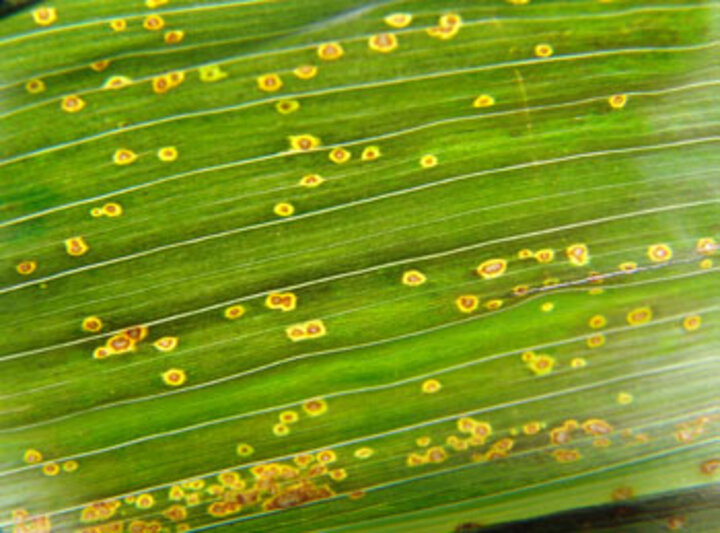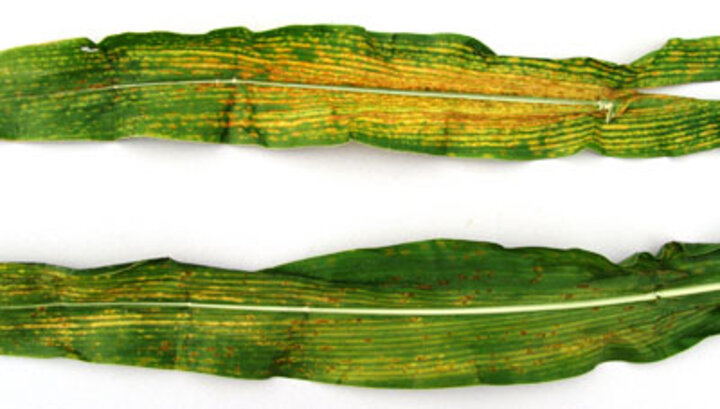July 31, 2009
Corn Disease Update
Eyespot of corn, caused by the fungus Kabatiella zeae, was confirmed in Antelope County this week and is likely present in other northern Nebraska counties. The disease is increasing in northern Iowa and has already been reported as severe in other areas of the Midwest.

Figure 1. Small lesions associated with the foliar corn disease, eyespot (Photos by Casey Schleicher)
|

Figure 2. Small lesions associated with the foliar corn disease, eyespot, are surrounded by yellow haloes that are visible when backlit by the sun. |
In Iowa, some producers have chosen to apply foliar fungicides as the disease has been exacerbated by prolonged, unusually cool temperatures and sometimes is developing on leaves above the ear leaf. Damage caused by this disease is seldom severe, but can cause plant death in severe cases and be accompanied by yield losses of up to 9% when the disease develops early on young plants. This pathogen requires cooler temperatures, which is why we normally see it as a short-term, early season disease in Nebraska. However, below normal July temperatures and high humidity likely spurred increased development of the disease this year.
Eyespot Symptoms
Disease symptoms are characterized by the development of small circular tan lesions (1-4 mm in diameter) that are surrounded by a brown or purple margin and a yellow, translucent halo that can be seen when held up to the sunlight (Figures 1 and 2), giving lesions the appearance of eyespots. The appearance of these lesions will vary by hybrid. Lesions generally develop on lower leaves first, and can fuse to cover the entire leaf.
The pathogen survives on corn debris, so reduced tillage and planting continuous corn creates a high-risk environment for eyespot development, especially if there is heavy residue and a history of eyespot in that location. Lesions can develop quickly under favorable weather conditions, in as little as 4-10 days (in contrast to gray leaf spot which may require two to three weeks for visible lesions to develop), so producers and consultants should continue scouting to monitor the development and spread of this and other diseases.
Eyespot Management
If you are considering applying a foliar fungicide to control eyespot in corn, carefully consider the economics — especially your yield potential, the value of the crop, fungicide application costs, and the weather forecast. This disease is favored by cool, humid weather, like that being experienced in many areas of the state; however, this could soon change. Development of hot, drier weather will help slow disease progression and eliminate the need for a fungicide application.
For longer term management of corn eyespot, consider a corn hybrid with resistance to eyespot if you’ll be planting corn in a location with a history of substantial disease.
Gray Leaf Spot
As reported in a July 10 CropWatch article, gray leaf spot is more severe in some Nebraska fields this year than in recent history. Continue scouting to monitor the development and spread of this and other diseases, as they will continue to get worse with the return of warmer and wetter weather conditions. For more information about gray leaf spot, see the UNL Extension NebGuide, Gray Leaf Spot of Corn.
Disease Lesion Mimic

Figure 3. Corn leaves with symptoms suspected to be a genetic disorder called a disease lesion mimic. Symptoms are triggered by environmental conditions. |
A common symptom on recent corn samples submitted to the UNL Plant and Pest Diagnostic Clinic is likely not caused by a disease pathogen, but instead a genetic disorder that causes lesion development under stressful conditions.
The symptom was previously reported in Nebraska, particularly in 1999 (Loren Giesler, UNL Extension plant pathologist) and since 2005, and across multiple hybrids from several companies in numerous counties. The symptoms may behave and appear similar to a residue-borne foliar disease because they can begin on the lower leaves and spread up the plant, but no pathogen has been confirmed in samples.
The likely cause of this symptom is a genetic mutation called a disease lesion mimic (Figure 3). More detailed information on disease lesion mimic mutants in corn is in an article by Dr. Gurmukh S. Johal, Purdue University, and published on APSnet.org, the American Phytopathological Society’s Web site.
Information Resources
For more information about these and other diseases and their management, see the UNL Extension Plant Pathology team’s Web site, Plant Disease Central, which includes the results of recent foliar fungicide trials conducted in Nebraska, as well as instructions and forms for submitting samples to the UNL Plant and Pest Diagnostic Clinic.
Tamra Jackson
Extension Plant Pathologist
Amy Ziems
UNL Plant and Pest Diagnostic Clinic
